| |
A Look at "Freestyle" and "Mira"
Two
new technologies that will extend the reach of Windows
PCs
During the Consumer Electronics Show (CES) in early
January 2002, Microsoft unveiled two technologies
designed to extend the reach of Windows PCs from the
office into the far larger and more lucrative living
room. The plan, launched through the company's eHome
Division, aims to leverage the power and intelligence of
the PC while offering simplicity and convenience for
consumers.
Currently, PCs are powerful, but limited to specific
tasks. As we move toward a more connected world where
digital media experiences such as music, photos, and
movies are used more and more with PCs, it makes sense
to bring that machine into other areas of the house.
Freestyle and Mira address this need. With Freestyle, a
new generation of TV-based PCs, or PCs used in smaller
living areas such as dorm rooms and apartments, is made
more viable thanks to a simple new user interface. And with Mira, a new
generation of smart screens will "remote" the desktop
experience to anywhere in the home.
Let's take a look.
Freestyling into the Living
Room
I received a preview of Freestyle the morning before Gates' CES 2002 keynote address
and found myself immediately impressed. eHome Division general manager Kevin
Eagan told me that Freestyle builds on the foundational digital media technology in
Windows XP and enables a simple user interface for those digital media tasks that
can work with a remote control, rather than a keyboard and mouse.
"The PC is moving out of the home office and into
the den," Eagan told me. "It's a complete UI that separates the old 'two foot
interface' from the new, remote-enabled 'ten foot interface.' It extends the
attraction of the PC. The remote control is for 'consumption mode' but I don't
necessarily want to edit my home videos with it."
So Freestyle provides a very simple user interface
(Figure) that obviously harkens back to the XP interface style, which is not a surprise
since XP UI guru Joe Belfiore is now working for the eHome Division. Users can
connect a Freestyle-enabled PC to a television set and home stereo and use a
remote to view home videos, music and photos, watch DVD movies, and program
Digital Video Recorder (DVR) capabilities through an onscreen program guide (Figure). And
the DVR allows you to watch, pause, and record live TV like you would with a
TiVo or Ultimate TV device.
The key here, I think, is the interface and the
underlying power of the PC. The interface is simple yet stunning, and it seems
that Microsoft has really thought through all the tasks you'd want to perform.
For example, you can listen to a music playlist while displaying a photo
slideshow on the TV. What the PC brings is storage and versatility. You can
store your music, photos, and videos on its hard drive, and access network
resources as well, if you have other PCs at home elsewhere in the house.
For Freestyle to come together, however, a new
generation of stereo component-like PCs will need to be created. Microsoft says
that these are on the way.
"We're working with leading consumer PC makers
such as Hewlett-Packard, Samsng, and NEC and are very focused on delivering this
technology in consumer PCs," Eagan told me. "But XP provides a whole new
platform for reliable devices; we can build on top of and expand the ways we
can deliver experiences to consumers."
While Eagan declined to comment on how Freestyle
would be delivered, he did say that Microsoft had a two phase schedule for
rolling out the technology. First, during the current "anywhere in the room
phase," the company will expand PC relevance with a remote control interface so
that you can use a PC in your living room. Then, the company will build on
networking features like 802.11b and power line networking to deliver rich
experiences anywhere in the room. The PC, he said, is key because it can offer
both security and entertainment. "Nowhere is innovation happening more rapidly
than with the home PC," he said. "It's gotta be plug and play, and offer an out
of box experience where the consumer can expect it to work easily, and just
start using it."
A Mira on the future of
Mobile Computing
I didn't have a chance to play with Mira until after Gates' CES keynote, but
this technology, which extends the Windows experience to a new generation of
smart displays for use anywhere in the home, also shows promise. Aubrey Edwards,
the Director of the Embedded and Appliance Platforms Group at Microsoft showed
me a prototype ViewSonic LCD display that looks like a normal PC display (Figure). But
the Mira-enabled screen can be picked up and carried around the house; the user
interacts with the PC back in the home office using wireless networking,
Terminal Services technology, and a stylus. It's perfect for Web browsing, and
other tasks which don't require heavy keyboard input. The obvious comparison,
however, is with the Tablet PC. I asked Edwards about this.
"Mira is aimed at home, not knowledge worker," he
said. "It's all about the home consumer experience, extending the Windows
experience to the whole home. The power requirements for a display vs. a full OS
is very different: A Mira display uses about 32 MB of RAM and a similar amount
of ROM, runs Windows CE .NET, and features a relatively low performance CPU. But
a Tablet PC will have a full speed x86 processor, a hard drive, and other PC
components. There's no hard disk in a Mira display, no moving parts. Instead,
all the applications are central in this model, so there's very little device
management required."
By remoting the full power of a desktop PC to
anywhere in the house, users will be able to share photos in the living room,
say, instead of requiring people to crowd around the PC in the office. You can
browse the Web from the couch, or answer email from bed. The Mira screens will
use a stylus and Pocket PC-style pop-up virtual keyboard for input, instead of
the full handwriting recognition features used by the Tablet PC.
A future generation will expand these capabilities
to other devices. Microsoft sees homes being built with multiple smart screens,
including fold-down units for under kitchen cabinets, and next-generation TV
sets which include Mira functionality. Presumably, any display could be
retrofitting with this technology and new uses will appear as well.
The Mira device I tested seems to respond slowly,
but Microsoft chalked that up to heavy wireless activity at the show. I believe
them, I guess, but I'd like to see how it fairs in a more typical environment.
I'm expecting to visit the campus in March, so I'll probably have an update
then.
Conclusions
Both
Freestyle and Mira will ship by the end of the year, though Microsoft is
currently mum on how this will happen. Mira is an obvious candidate for
inclusion in Windows, but Freestyle could take one of several paths to release. I
could see Microsoft issuing a "Freestyle Edition" of Windows XP, for example, that
would only be included in special new consumer oriented PCs. Or perhaps the company
will issue it as an add-on pack similar to Plus!XP. Or finally, it's possible
that Freestyle will simply ship in a Windows refresh (Windows XP Second
Edition?) or in the next Windows version, code-named Longhorn. A Microsoft
executive I spoke with at the show admitted that they were considering all three
of these options.
However they appear, it's clear from my hands-on
time with both technologies that they will usher in a new era of PC computing,
and it's exciting to see the market changing into something that will benefit a
far bigger audience. These are definitely two technologies to watch.
--Paul Thurrott
January 14, 2002
|
|
Screenshots & Photos
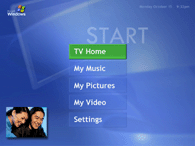
The Freestyle Start screen.
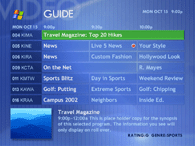
Freestyle's TV Guide lets you
set DVR recording times (the red dot) and look at the schedule.

You can also access your home
video collection--and view DVD movies--with Freestyle.
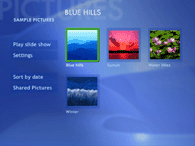
Here, some of the user's
photos are displayed...
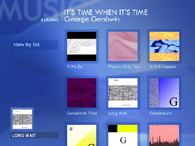
...and here is a music view.
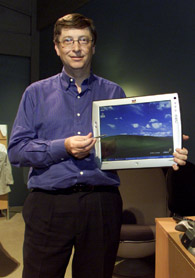
Microsoft Chairman Bill Gates shows
off the ViewSonic Mira prototype.
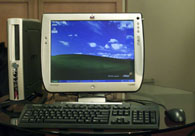
Viewsonic's Mira prototype screen
can be picked up and carried around the house.
|

